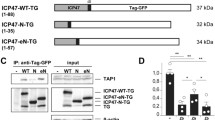Abstract.
Data are presented on the intracellular trafficking of HLA-G protein, taking the unique features of this non-classical molecule into consideration: the existence of seven isoforms resulting from alternative splicing (HLA-G1 to G7), and reduced tail length compared with HLA class I antigens. Biochemical studies and analysis of viral strategies for escaping the host immune system led to the demonstration that (i) both the membrane-bound (HLA-G1) and the soluble (HLA-G5) forms of the molecule require peptide association for cell surface expression, using TAP-dependent or TAP-independent pathways; (ii) peptide loading onto the HLA-G protein plays a critical role in controlling the quality of the molecule reaching the cell surface; (iii) surface expression of truncated HLA-G molecules is possible, and (iv) HLA-G expression may be restricted to soluble HLA-G5. These data reveal that HLA-G presents specific cell trafficking pathways and strongly support the contention that the primary function of HLA-G is as of an inhibitor ligand for immune-competent cells.
Similar content being viewed by others
Author information
Authors and Affiliations
Additional information
Received 4 June 2002; accepted 2 July 2002
RID="*"
ID="*"Corresponding author.
Rights and permissions
About this article
Cite this article
Moreau, P., Rousseau, P., Rouas-Freiss, N. et al. HLA-G protein processing and transport to the cell surface. CMLS, Cell. Mol. Life Sci. 59, 1460–1466 (2002). https://doi.org/10.1007/s00018-002-8521-8
Issue Date:
DOI: https://doi.org/10.1007/s00018-002-8521-8




